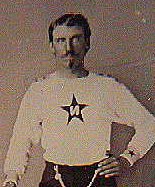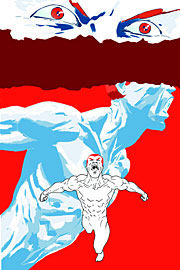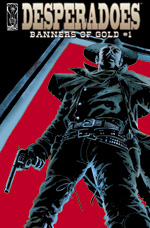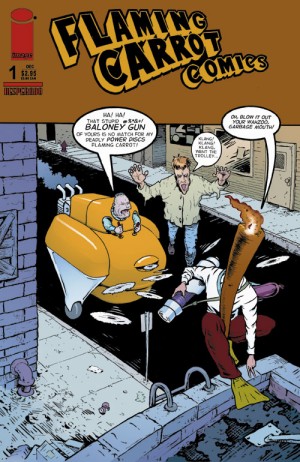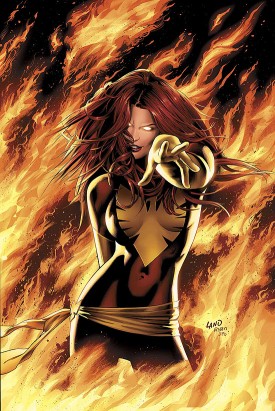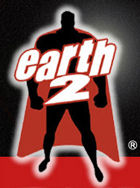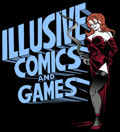|
|
|
|
Jason
Schachat faked his own death in order to fight crime
in secret, but then started websurfing instead.
|
Jason
Schachat's Weekly Breakdowns
January 10, 2005 Oh,
lord...
I was
so busy washing the Constantine trailer out of
my eyes by playing hours and hours of City of Heroes, I
forgot to pay my respects to the late Will Eisner. He truly
was the best, knowing more about visual storytelling than
any before him. A genius until the end.
For any who want to understand more about
comics and how to do them right, his Comics & Sequential
Art is absolutely mandatory reading. For any who just want
some good damn comics from the Golden Age on, his Spirit
Archives have been released in hardcover by DC. Read them.
You won’t be sorry.
Sadly,
DC has spent recent months pushing Breach
#1 rather than any works of Eisner,
but this first issue is neither original or promising. Derek’s
Spotlight summed up the book as being lifted from DC’s
version of the Captain Atom origin. I never got into that
volume (though I have read Ditko’s version from the
‘60s, oddly enough), but I’d go even further
and say this is the typical “superhero created by
meddling in science” story.
Set with the late Cold War as a backdrop,
this book gives us a flashback to the creation of the main
character. He lives a happy suburban life and everything
is going swell. Then, fitting the usual cliché, his
best friend betrays him, marries his widow and becomes father
to his son, and our hero metamorphoses into a super-powered
being.
|
|
|
Like
many angry youth, what ticked Breach off the most
is that he wasn't doing anything remotely original.
|
As with so many comic books these days,
Breach seems terrified to approach contemporary subjects,
so it looks like our first adventure will be yet another
jaunt to an abandoned facility in the Russian wilderness.
Of course, if the story decompression continues to follow
the standards that have pretty much sunk all other recent
superhero debuts, we’re in for an issue where he learns
to harness his powers, another where he learns the “truth”,
one where he gets assigned the big mission, and another
where he learns the REAL truth.
So, no, I’m not exactly dancing with
joy over this one.
More to the point, even the production on
this book doesn’t bring enough to it for me to recommend
it over back issues of damn near anything that told the
same story. Unless something boldly original happens next
month, I’d say DC has another cancellation on their
hands. At the moment, it’s not looking good.
Captain
America #2 (yes, if you weren’t paying
attention, we’re on the fourth new volume in less
than ten years, now) throws some more spy fodder on the
fire in the never-ending attempt to make a Captain America
that works. If I sound bitter it’s because I am. Seriously,
how hard is it to make a guy named Captain-freaking-America
appealing in such nationalistic times?!
But I digress.
This month’s issue reassures us that
we did, in fact, see the Red Skull take a fatal shot to
the chest, last time around. Then Cap spends the entire
issue hunting for a bomb and mumbling that it must have
been an imposter. Skull’s henchmen are led around
by another fascist psycho in a skull mask, but he does us
the honor of not making any speeches or filling panels with
exposition.
Instead, Ed Brubaker devotes much of his
story to making Cap an ass-kicking investigator much like
Batman without the whole “I am Winged Death”
thing. It’s a decent characterization, but maybe a
little too dry. This Cap nicely bounces around the fence
between right and left, but the only depth we get is from
his flashbacks and nightmares of World War II. It’s
better than what we’ve had over the last couple years,
yet still not quite there.
Steve Epting brings a fantastic look to
the franchise, and Michael Lark’s flashbacks are spot-on,
but I’m afraid nothing will ever excite me as much
as John Cassaday’s work on the last volume. This new
series has some strong creators. No denying that. But what’s
so exciting about another Red Skull story with Bucky flashbacks?
The overall result is better than mediocre, but we’ll
have to see some big developments in the next few issues
for it to be much more. As is, I don’t anticipate
more than another decent Captain America run that ultimately
won’t change the status quo.
|
|
|
Hey,
it's an IDW comic --
where's the horror?
|
When
I picked up Desperadoes: Banners of Gold #1,
I was expecting an out and out Western. The realistically-styled
art painted some beautiful faces and stark backgrounds while
the dialogue hinted at a natural attempt to capture the
Old West. By the end of this issue, I found even more.
Without
giving too much away, I can tell you this book focuses on
a group of gunslingers who’ve worn out their welcome
in the Arizona territory and are hired by a woman to provide
escort through New Mexico, where they’re even LESS
welcome. The next morning they learn not only will they
be shepherding an entire wagon train, but their charges
happen to be a group of mystics. And, of course, things
go from bad to worse when they travel through some spiritually
active terrain.
However,
this issue never shows any ghosts or supernatural activity
whatsoever. It’s subtle to a fault, making the opening
pages somewhat tedious but building the story toward an
ending that would be trite anywhere else but, in this case,
leaves the reader wanting more. Smartly, the authors then
follow with a listing of previous Desperadoes miniseries,
saving us the trouble of playing catch up when this one
begins yet also demonstrating storytelling clear enough
to suck us right in.
Maybe
I’m just finding myself surprised to find a well drawn
(thanks to the pencil of Jeremy Haun) cowboy story that
works (thanks to the pen of Jeff Mariotte), but Desperadoes:
Banners of Gold is one I have to recommend. This issue
barely gives us a taste of what’s to come, but I already
know I want more. It certainly isn’t the usual disappointing
Western.
Fantastic
Four: Foes #1, unfortunately, is the typical
Robert Kirkman/Marvel experience: There’s some wit,
some dredging up of old storylines and characters, and some
gut feelings that the miniseries will ultimately go nowhere.
Kirkman starts out his story from the perspective
of a normal guy who just happens to work in the Baxter Building,
but quickly shifts focus to the Fantastic Four and that
dastardly fiend The Puppet Master. Sue Richards takes Franklin
to school after Ben plays a trick on Johnny, and other mundane
events take place, but then Puppet Master reveals his maniacal
plan: to bring all the Four’s nemeses together and
take over the world!
Hey, I said he was dastardly, not original.
The
great weakness of this story is in the timing. It really
isn’t all that different from Kirkman’s recent
Super Patriot miniseries, but the few jokes that
make it through are weak and lack the proper setup. To take
Fantastic Four: Foes seriously is to completely
miss the point, but the end result simply isn’t absurd
enough to allow anything else. And, unfortunately, the characters
appearing in this issue don’t gel with recent events
in the Marvel Universe.
Hell, some of these villains are dead.
Maybe Kirkman will be able to make a Marvel
book worth sticking with, some day, but this story doesn’t
give us any reason to hope. If you want an entertaining
adventure with the Fantastic Four, read the last few issues
of the soon-to-end Waid/Wieringo run. Pass on this one.
It’s
been two years since the last issue of Flaming Carrot, but
the character’s still as hilarious, violent, and lovably
retarded as ever. Fitting their new… well… image,
the newly Berkeley-based Image Comics adds this madcap series
to it’s repertoire, re-numbering what would be issue
#33 as a shiny new first issue -- another Flaming
Carrot #1.
To attempt a summary is an exercise in futility,
but the story essentially consists of our hero trying to
create a new, politically correct reputation after finally
defeating the evil Garbage Mouth with the aid of his trusty
baloney gun. The episode lands Flaming Carrot with a new
zombie sidekick who communicates only through convenient
song lyrics and gets him a date with a sexy reporter looking
to dig up dirt on the combustible vegetable.
Oh, and some pygmies are building a giant
ear out of french bread near the woods (Though debate continues
as to whether it’s an ear or a bellybutton).
Flaming
Carrot is, of course, f**king bizarre, and you shouldn’t
come to it expecting anything remotely epic or heroic. That
said, it’s the funniest damn thing I’ve read
in weeks. Bob Burden’s art isn’t as consistent
or well-rendered as David Boswell’s work on Flaming
Carrot & Reid Fleming, World’s Toughest Milkman,
but it fits the wacky humor like a glove. Strongly recommended
to anyone smart enough to read black and white comics…
and even to those who aren’t.
You
know, it really has gotten to the point where Flash should
be re-titled “Rogues Monthly." The
Flash #217 gives Captain Boomerang his last
rites (following the events of Identity Crisis),
and it makes sense enough, but all the characterization
and plot movement comes from the Rogues’ Gallery rather
than the book’s supposed hero.
But the big news for Flash is that he and
wife Linda Park are back together again and as in love as
ever. Wally West’s newly hidden identity has allowed
Linda to restart her reporting career and assert herself
as the more famous member of the family, thus patching up
a few holes in the relationship.
Meanwhile, the Rogues and their allies assemble
for Captain Boomerang’s funeral and launch a Boomerang-themed
crime spree in honor of their fallen comrade. The new Captain
Boomerang is readily welcomed into the fold by his father’s
partners, and things are heating up for the big confrontation
between the Rogues and their reformed comrades who now work
for the government and have one hell of a chilling ace up
their sleeves.
So, why is this book still called “Flash”?
Seriously. It’s enjoyable, but Geoff Johns doesn’t
seem to have much more to say about Wally West. There was
no mistaking, even during his first arc, that the Rogues
would play a stronger role in the book, but this series
has ridiculously little to do with the Speedsters, these
days.
What’s more, next month is going to
be a profile on Heatwave.
Yes, Heatwave.
Fans who want a more Flash-filled book should
probably start looking for back-issues. Rogue-lovers: these
days are yours. You don’t want to let them pass you
by.
|
|
|
Admit
it. She's so hot, you'd risk immolation.
|
I skipped
out on Greg Pak’s Warlock miniseries because
Chris Garcia showered
the man with so much praise (and it didn't get us
a thing, dammit - ed.), I couldn’t imagine myself
writing a truly objective review. I felt much the same pangs
when I picked up X-Men: Phoenix Endsong #1
but just couldn’t resist the promise of Pak teaming
up with artist Greg Land.
This miniseries kicks off in true epic fashion
with the re-emergence of the Phoenix Force— this time
without the Jean Grey component. Yes, Shi’ar scientists
have forced the galactic destroyer back into existence so
that they might destroy it forever with… well…
some kinda… mumbo jumbo doohickie that sounds like
a creative interpretation of a quantum singularity.
Of course, this doesn’t have a prayer
of working and the Phoenix Force soon finds itself wandering
the Xavier School in a severely weakened state. It bobs
around, poetically questioning its purpose and what it needs
in life, visiting Wolverine, Beast, and Cyclops before suddenly
remembering “Oh, yeah; I like being Jean Grey”.
I still
think it’s too soon to bring Jean back (though no
one expected her to be dead for long), but Pak takes a nice,
lyrical approach fitting to the material. It moves pretty
slowly, but the characters behave true to form even if their
voices seem relatively indistinct. However, what works best
are Pak’s efforts to tie the mini into the events
of New X-Men. The Stepford Cuckoos, the Jean-Scott-Emma
love triangle, and Quentin Quire are given the first serious
attention they’ve gotten since Grant Morrison left
the franchise, and it feels good.
And, despite Greg Pak’s somewhat hit-or-miss
opening, Greg Land’s art sucks you in from page one.
His work has always been gorgeous, but the work he and John
Cassaday have put into these recent stories make every other
X-book look like finger-paintings. The art alone is worth
three bucks. The story may not have the same instant appeal.
It has potential, though.
But
“Endsong”? Pssh! Yeah, like we’re believing
THAT for an instant.
|
